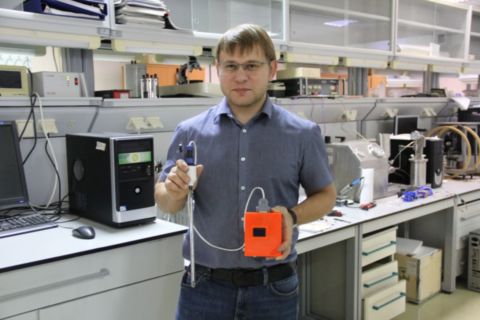Temperature meter, detector, sensor − all these are the names of the device that has been developed by employees of the SUSU Research Institute for Non-conventional Materials and Resource-Saving Technologies. The device measures temperature many times more accurately than similar devices currently available in the world.
"Most often a thermocouple, thermal resistance, and thermister are used in industry and technology. All these types of thermometers have a property that is commonly called “aging”: over time, the readings deviate from the standard, and the error can reach from 5 to 15⁰C," says Vladimir Zhivulin, senior researcher at the SUSU Crystal Growth Laboratory. "Now this problem is solved in such a way that after a certain period of time the sensor is removed from the device and checked. For example, in our laboratory furnaces it is necessary to calibrate the thermometer once every six months, and in industry − after each technological process."
However, there are industries where it is almost impossible to perform maintenance of a temperature sensor: for example, on a space satellite or a nuclear power plant. Until now, this problem has been solved by labour-intensive and low-tech methods, for example, by duplicating sensors tenfold. But in hazardous industries, an emergency situation can always occur, and a thermometer (or several thermometers) can be damaged literally immediately after calibration, transmitting incorrect results.
.jpeg)
Chelyabinsk scientists have created a sensor that can independently verify itself − every heating-cooling cycle.
"We have a main temperature meter and a standard one with which we compare the correctness of the sensor readings at control points. All this is a single capsule, a monoblock," explains Vladimir Zhivulin. "If we see that there is a deviation from the control points, we can calculate the temperature correction that needs to be entered and restore the true values. Our discovery relates precisely to material science: we use ferrites. This is a very stable, chemically inert, temperature-stable material; it is not affected even by a large background radiation."
Ferrite is a magnetic material, and phase transitions occur in it: when heated to a certain temperature, it becomes non-magnetic. Chelyabinsk materials scientists from a scientific school headed by RAS Professor Denis Vinnik have learned to controllably change the temperature of the magnetic phase transition of ferrites. The idea was put forward that by recording the magnetic phase transition, it was possible to accurately determine the temperature. The head of the International Laboratory for Self-Validating Sensors, Systems, and Advanced Instrumentation Aleksandr Shestakov proposed creating a sensor where a ferrite element would act as a temperature standard. Thus, within the framework of the Priority 2030 program, a collaboration of several scientific schools took place. An employee of the Department of Informational and Measuring Technology, Nikita Nikolaizin, began creating electronics for controlling the sensor, and the design of the sensor itself was invented by Vladimir Zhivulin, a physicist by training. He was the first to figure out how to detect a magnetic phase transition and create a single device.
"The development itself consists of a sensitive element that contains reference substances, a main temperature meter (thermocouple), and the second part is a software and hardware complex, an electronic circuit that collects data from the sensor, makes calculations and automatically issues a signal that something is wrong, or it calculates correction factors, applies them and corrects the thermocouple readings," says the inventor.
.jpeg)
The entire development, from material to design, including electronics, was designed and manufactured at South Ural State University. Now a prototype is ready and operating, scientists are testing it. The uniqueness of the project is that Chelyabinsk developers can reproduce the full cycle of creating an "ageless" thermometer without resorting to third-party organizations.
There is only one industrial analogue in the world that can be bought, it is produced by Endress+Hauser, but the device by the Chelyabinsk scientists surpasses it in all characteristics. The German sensor can carry out verification or calibration using just one temperature standard, and the Chelyabinsk device has five calibration points, and they are evenly distributed over the entire operating temperature range. The foreign device operates at temperatures from 0 to 200 degrees Celsius, and the Chelyabinsk sensor − from 0 to 800. This range is widely used in industry: nuclear energy, metallurgy. In addition, the "ageless" thermometer from Chelyabinsk will find use in scientific laboratories; it can be checked and calibrated after each experiment. According to preliminary estimates, the accuracy of the sensor will be 1 degree. No thermocouple existing in the world can provide temperature measurements over a long period of time with such accuracy.
The sensitive element itself has been 100% completed and tested. Electronics has been developed to control the sensor. Now scientists are giving their invention "brains": they are developing algorithms for the controller so that it can automatically perform verification and automatic calibration without errors. Within a year, the device will be perfected and ready for transfer to industrial production.




